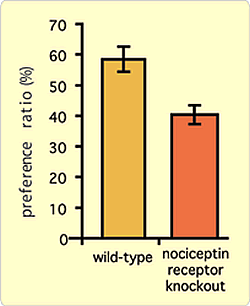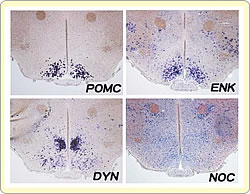According to the Four Noble Truths of Buddhism, worldly life is unfulfilled because of an insatiable desire for pleasure known as tanha. The word tanha can be translated into English in several ways, such as "wanting", "craving" and "addiction". Research in our unit aims to understand these phenomena, especially addiction. Tanha is the natural consequence of the most fundamental driving force in human life- the desire to experience the pleasure that comes with doing things that simply keep us alive. Without this drive to fulfill our desires, we would lack the incentive to interact with our world and gain the experience required to succeed.


Affective and Hedonic States
When people ask us how we feel, they are asking us to consider our so-called "affective state" (Fig. 1). Our affective state is made up of many component processes that may loosely be called "feelings", such as joy, anxiety, boredom and anger. One of these processes is called the "hedonic" state. The word "hedonic" means "of, relating to, or characterized by pleasure". Simply put, our hedonic state is the degree of happiness or unhappiness that we are experiencing at any given moment in time.
One interest of our unit is to understand how the hedonic state of the brain is maintained, and how might it become unbalanced such as in disease. Several different neurotransmitters and neuromodulators mediate pleasure in the brain. However, if you asked someone to name only one, then they would be most likely to mention endorphins. Indeed, endorphins are one of a larger group of molecules, known as opioid peptides that act primarily as neuromodulators (Fig. 2). We have recently found that opioid peptides work together to produce equilibrium in the hedonic state of the brain. Mice, like humans, return to places where they have previously experienced pleasure. Using this simple fact, we have found that removing the influence of the most recently discovered opioid peptide, "nociceptin", allows an increase in hedonic state that we experience as pleasure (Fig. 3).
This discovery that the brain has mechanisms to prevent us from experiencing too much pleasure is fascinating. Importantly, this discovery has important ramifications for disease states where there are long-term changes in the ability to experience pleasure, such as drug addiction and depression.
Addiction is Not Just About Drugs
Ask yourself, is there anything in your life on which you are dependent or addicted? Most people believe they are not addicted to anything at all, and only a few will acknowledge any kind of dependence. However, there are many things that if they were suddenly taken from us, we would feel a sense of loss. This is the very definition of psychological dependence. Addiction is only one step beyond this, where one will go to unusual lengths to have those things we lost returned, often at the expense of other important things. In this sense, our lives are full of "natural" addictions, such as good food, warm and safe places, companionship and social attachments. Amongst these, compulsive eating, i.e. addiction to food, has become a massive concern. Obesity has reached epidemic proportions throughout the Western world, and even Japan has seen a doubling in childhood obesity since the 70's. In fact, obesity is expected to soon become the leading cause of preventable death in Western society.
The increased prevalence of obesity is largely attributable to two factors: a decreased rate of physical activity, and over-consumption of diets that are usually tasty and pleasurable. Interestingly, we found that mice lacking nociceptin receptors show the highly unnatural behavior of avoiding sweet diets (Fig. 4). These studies highlight the importance of opioid peptides in the control of motivation to find not just addictive drugs, but also "natural" rewards.
The Neurochemistry of Motivation and Reward
Our understanding of the neural circuitry that mediates the expression of pleasure has been greatly influenced by the discovery of a group of neurons known as the "mesolimbic dopamine tract" in the 60's. This tract, which springs from the midbrain and terminates in the ventral forebrain, appears to be the major conduit for neural flux carrying information about the availability, desire to consume, and rewarding aspects of pleasurable stimuli (Fig. 5). Activation of the mesolimbic dopamine tract typically accompanies increases in the hedonic state of the brain. Thus, it is not surprising that the dopamine contained in the mesolimbic tract has been long believed to be the neurochemical currency of pleasure. This view is widely held and can be found in many forms of media, from scientific papers to magazines.
Bolstering the amount of nociceptin in the brain appears to reduce the pleasure experienced from drugs such as cocaine and alcohol. Indeed, if we measure release of dopamine from the mesolimbic tract at this time, we see less dopamine is released. These results fit with the long-standing hypothesis that mesolimbic dopamine actually underlies pleasure. However, further studies lead us to challenge this hypothesis. That is, we find that removing the influence of endogenous nociceptin from the brain is pleasurable, yet this pleasure occurs independently of activation of the mesolimbic tract (Fig. 5).
These findings indicate that the systems of the brain mediating the desire for pleasure, and the systems that mediate the experience of pleasure are dissociable. An interesting outcome of this finding is that we could desire things that we do not enjoy. Conversely, we could conceivably enjoy things that we do not desire. Much further study is required to say if this is true, but such speculation is reminiscent of what drug addicts often say. That is, they often crave drugs that do not necessarily bring them much pleasure. Perhaps, this is why highly desired things can turn out to be an "anticlimax" - our experience of them simply does not always live up to how much we want to experience them.
The Way Ahead (The Path to Enlightenment?)
The teachings of Buddhism say that trying to obtain enduring happiness is as fruitless as a dog chasing its tail. That is, happiness is a fleeting experience that cannot be held for long and thus must be constantly pursued. From a behavioral perspective, a permanent state of happiness would sap our motivation to do things necessary for maintaining our lives, and ultimately passing our genes to the next generation. In this sense, as the thrill of experiences that once made us happy "wears off", we search for new and novel ways to find happiness. This, perhaps, is the precise means by which we obtain the new experiences that make us flexible to our environment. However, we rarely forget what previously made us happy, and often we continue repeating behaviors learned from such experiences despite receiving little gratification from them. In fact, we often call these behaviors "habits".
Understanding how the brain controls the desire to find pleasure, and why pleasure may fade is critical in understanding all aspects of our life, not just addiction. Our research aims at the heart of this issue, and there is plenty more to find out. This is something we will endeavor to do, for one thing that makes most people happy is a sense of revelation.









